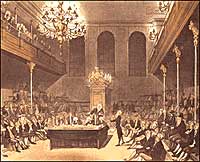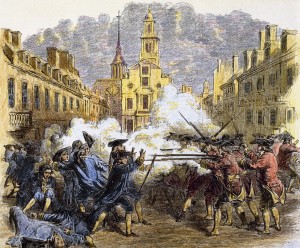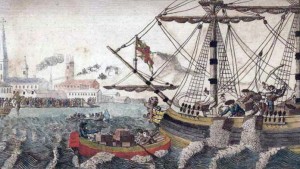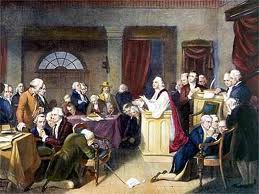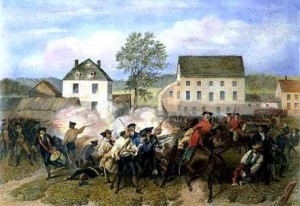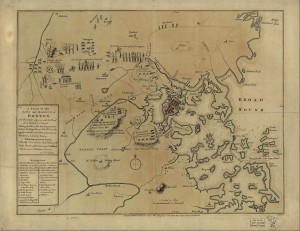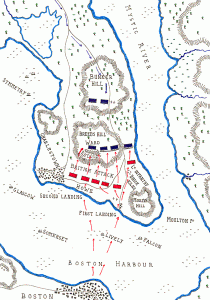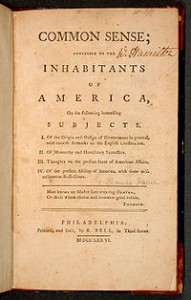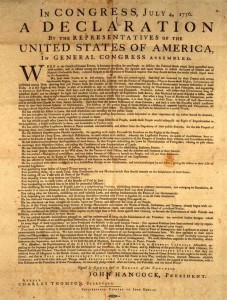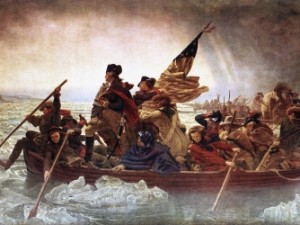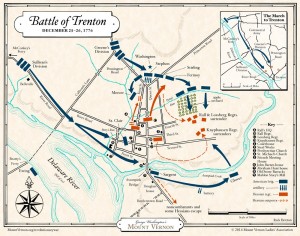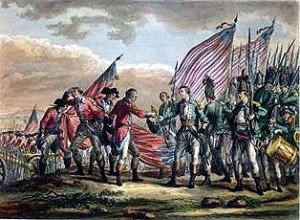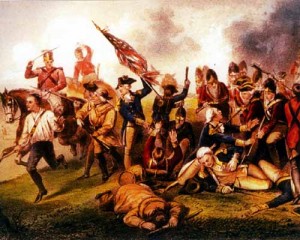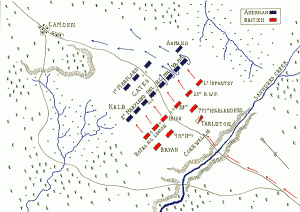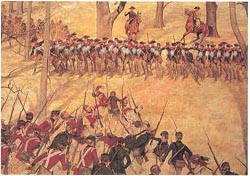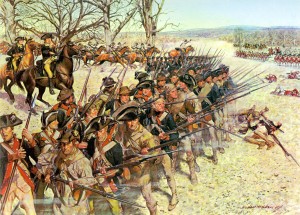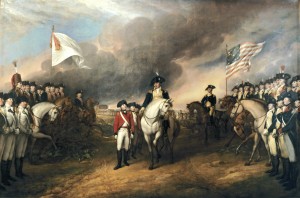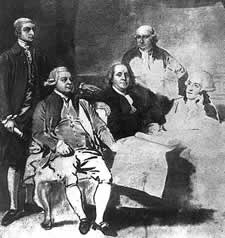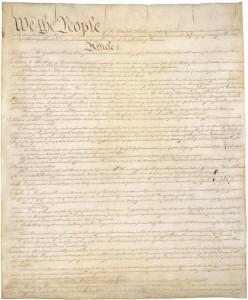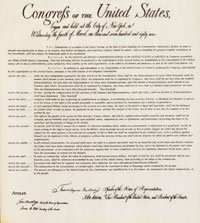Causes Of The American Revolution:
Stamp Act 1765
The stamp act was a stamp that had to be purchased and then stuck on item that were bought and sold. It was made to raise money for the colonies. The stamp act was a disaster and Americans were enraged because they felt they were getting taxed without their consent which they called taxation without representation. The stamp tax had to be paid in valid British currency, not in colonial paper money. British merchants and manufacturers, whose exports to the colonies were threatened by colonial boycotts, pressured Parliament. The purpose of the tax was to help pay for troop This act was repealed in 1766.
The stamp
https://en.m.wikipedia.org/wiki/Stamp_Act_1765
Townshend Acts
Townshend acts were new duties on paper, paint, glass and tea, anything that is brought into the country. They made Townshend acts to prove that they had the right to tax people. Many Americans believed that Parliament had no right to impose any taxes on the colonists, viewing taxation as an abuse of power. The Americans protested and the act was abolished, except for the Taxes on tea because they wanted to control the supply on tea, leading to a temporary truce between the two sides in the years before the American Revolution.
The House of Lords and House Of Commons combine
http://www.ushistory.org/us/9d.asp
Boston Massacre
The Boston Massacre occurred on March 5, 1770. Five Colonist were shot and killed by the British. Three persons were killed immediately when shot and two died later of their wounds. They called this event the Boston Massacre. A massacre is an indiscriminate brutal slaughter of a group of people.
The Boston Massacre
http://www.history.com/news/the-boston-massacre-245-years-ago
Tea Act and Boston Tea Party 1773
The Boston Tea Party was one of the most important and symbolic event leading to the American Revolution. People would dress as Mohawk Indians boarded British ships docked in Boston and dumped tea into the harbour as protest against the tea act. They were called the British East India company which controlled the supply of tea. The Boston tea act was one of the Most symbolic events leading up to the American Revolution.
The Boston Tea party
https://en.m.wikipedia.org/wiki/Boston_Tea_Party
Intolerate Acts 1774
Paliament passed a series of acts that were meant to punish Boston and assert British authority. These were called the intolerable acts. Most American colonist viewed these acts as a violation of there natural and constitutional rights. They also saw theses acts as a threat to the freedom of the British Americans.
Britians House of Lords
http://www.ushistory.org/us/9g.asp
First Continental Congress 1774
The First Continental Congress was a meeting of delegates from twelve of the thirteen colonies In 1774, the British parliament also passed the Quebec act. The Congress met briefly to consider options, including an economic boycott of British trade.
Jacob Duche leading the first prayer in the First Continental Congress
http://www.historywiz.com/continentalcongress.htm
Components of the American Revolution:
Battle of Lexington and Concord 1775
About 20 miles northwest of Boston, General Gage sent a detachment of 700 troops under Colonel Francis Smith to march to Concord for the purposes of seizing and destroying artillery and ammunition. When the British arrived, someone fired a shot that would become known as “The shot heard round”. Eight minutemen where killed and ten where wounded. Colonial workers hid from the Minutemen that where firing at them.
The battle of Lexington
http://www.landofthebrave.info/battle-of-lexington.htm
https://en.m.wikipedia.org/wiki/Battles_of_Lexington_and_Concord
Battle of Bunker Hill 1775
On the night of June 16, 1775, American troops moved out of their camp, carrying picks, shovels, and guns. The American troopers misunderstood Artemas Wards orders at by mistake went to Breeds hill and entrenched themselves. In the morning the British were stunned to see Americans threatening them. Ships open fire at the Americans. Early in the afternoon, 28 barges of British soldiers crossed the Charles River stormed the hills. Of the 2,300 British soldiers who had gone through the or deal, 1,054 were either killed or wounded.
The battle of Gunker hill
https://en.m.wikipedia.org/wiki/Battle_of_Bunker_Hill
http://www.britishbattles.com/bunker-hill.htm
Thomas Paine’s Common Sense 1776
Common Sense was an instant best-seller. Published in January 1776 in Philadelphia, nearly 120,000 copies were bought by April. Paine argued for two main reason, independence from England and the creation of a democratic republic. Paine was not religious but he quoted the bible in his book because he knew his readers where religious.
Common Sense
http://storiesofusa.com/signed-declaration-of-independence-preamble-signers-author-1776/
Declaration of Independence 1776
On June 7, 1776, Richard Henry Lee introduced a resolution to the Congress that declared the thirteen colonies “free and independent states.” These rights include the right to life, liberty and the pursuit of happiness. When a government fails to protect those rights, people have the right, to overthrow that government. Government are rarely overthrown but the people should astablish a government that can protect those rights. The King of Great Britain, George III, is guilty of 27 specific abuses. The King interfered with the colonists’ right to self-government and for a fair judicial system. He also removed their right to trial by jury, and prevented them from trading freely.
The Declaration of Independence
http://storiesofusa.com/signed-declaration-of-independence-preamble-signers-author-1776/
Battle of Trenton 1776
The first gunfire of the battle happened about a mile north of Trenton at a Hessian outpost, where the Hessians stationed there began a desperate retreat. Washington’s army was soon joined by armies under the command of Generals Nathaniel Greene and John Sullivan. 896 Hessians were captured, though several hundred did manage to escape. All four Hessian colonels, however, were killed.
Battle of Trenton
http://www.history.com/topics/american-revolution/battles-of-trenton-and-princeton
http://www.mountvernon.org/preservation/maps/map-battle-of-trenton/
Battle of Saratoga 1777
British planned to cut off New England from the rest of the colonies by taking New York, Albany and the Hudson River. Generals Burgoyne, St. Leger and Howe would meet at Albany to defeat the rebel armies. Burgoyne’s army became trapped in Saratoga blocked by General Gates. October 7, 1777 Burgoyne attempted to attack the larger Patriot force. Burgoyne’s army was defeated by Arnold’s army at Bemis Heights. Due to a lack of supplies and high casualties Burgoyne surrendered. Patriot victory at Saratoga was a turning point in the war. It renewed the morale of the Americans. It convinced France the Americans could win the war and decided to support the Americans. France sent generals, troops, ships, supplies, money to help Americans win the war.
The Battle of Saratoga
http://www.britishbattles.com/battle-saratoga.htm
http://www.history.com/topics/american-revolution/battle-of-saratoga
Battle of Camden 1780
The Continental Congress voted to give command of a second southern army to Horatio Gates, the hero of the Battle of Saratoga. On July 27th 1780, Gates set off for Camden with over 3,000 troops. Gates arrived near Camden on August 14th, with his 3,000 men, Gates’ forces still outnumbered the British forces. But the British forces were better equipped and included calavary as well as other extensive artillery. Gates realized he faced a difficult fight and that capturing Camden would be nearly impossible. Gates arranged his forces in a defensive position, a strategy that had worked well at the Battle of Saratoga. The Americans began a full retreat from the battlefield, losing over 600 soldiers in the process. The battle of Camdem was a complete American defeat.
The battle of Camden
http://www.britishbattles.com/battle-camden.htm
http://www.britishbattles.com/battle-camden.htm
Battle of the Cowpens 1781
after initial British charge the first two lines of Patriot fighters withdrew. Tarelton believed Patriots in full retreat and ordered soldiers to charge. Tarelton was not aware of a third line of Patriot fighters waiting for the British charge. British forces charged directly into the third line of Patriots who halted British advance with a bayonet charge. British soldiers surrendered and others turn and ran. British army was outflanked and Patriot forces began attacking the British from behind. British forces began to retreat despite Tarelton urging them to continue fighting. Morgan captured 712 British soldiers and 110 British soldiers were killed. the battte was a turning point Southern campaign. Cowpens ultimately was the first step in the eventual end of the war as it caused Cornwallis to abandon South Carolina, engage Greene at Guilford’s Courthouse and eventually withdraw his army to Yorktown where his army would eventually come under siege and surrender.
The battle of Cowpens
https://www.nps.gov/cowp/learn/historyculture/the-battle-of-cowpens.htm
Battle of Guildford Courthouse 1781
The battle of Guilford Courthouse was a battle fought on March 15th, 1781. The British force had 2100 men under the command of Lieutenant General Charles Cornwallis which defeated major general Nathanael Greenes 4500 Americans. The British army lost a considerable amount of men during the battle with estimates as high as 27%
Battle of Guilford Courthouse
https://en.m.wikipedia.org/wiki/Battle_of_Guilford_Court_House
Battle of Yorktown 1781
The Siege of Yorktown, also known as the Battle of Yorktown, the Surrender at Yorktown ended on October 19, 1781, at Yorktown, Virginia. Washington’s troops marched over 300 miles south toward Yorktown. Cornwallis was forced to surrender his entire unit of nearly 8,000 troops on October 19, 1781 as the French navy kept the British out of Chesapeake bay.
Battle of Yorktown
https://en.m.wikipedia.org/wiki/Siege_of_Yorktown
Consequences of the American Revolution:
Treaty of Paris 1783
Britain agreed to recognize American independence. They gave Americans fishing rights to the Grand Banks off the coast of Newfoundland. Britain granted U.S. all territory between Mountains on the east and Alleghen Mississippi River on the west.
The Americans peace commissioners
https://www.loc.gov/rr/program/bib/ourdocs/paris.html
Loyalists
approximately 20% American colonists supported British rule and remained loyal. Loyalists were persecuted by the Patriots during the war. Patriots abused them and burned their homes and farms after the revolution and Treaty of Paris was signed, between 80,000100,000 Loyalists had to leave U.S. many settled in other British colonies in North America Quebec, Nova Scotia and Island of St. John (PEI).
The loyalist
http://freepages.genealogy.rootsweb.ancestry.com/~apassageintime/registry.html
Constitution 1789
It outlines the structure and powers of three branches of government are government separate, balanced off by the power of the other two Bill of Rights in 1791. U.S. Constitution is supreme all persons are equal before the law p eople can change the constitution.
Constitution
http://www.studenthandouts.com/01-Web-Pages/American-History-Image-Gallery/Picture-Pages/United-States-Constitution-1789.htm
Bill of rights 1791
the first 10 amendments (additions) checked and of the constitution represent ideals regarding individual liberty, limited government, and the rule of law. The concepts in these amendments are built upon those found in several earlier documents, including the Virginia Declaration of Rights and the English Bill of Rights, along with earlier documents such as Magna Carta.
the bill of rights
http://www.freedomshrine.com/historic-documents/bill-of-rights.php
World wide influence
American Revolution spread ideas of liberty, individual rights and equality to other parts of the world. It influenced and inspired other revolutions around the world such as France in 1789. American Declaration of Independence had some impact on the French Declaration of the Rights of Man and the Citizen of 1789.
The worldwide Influince

